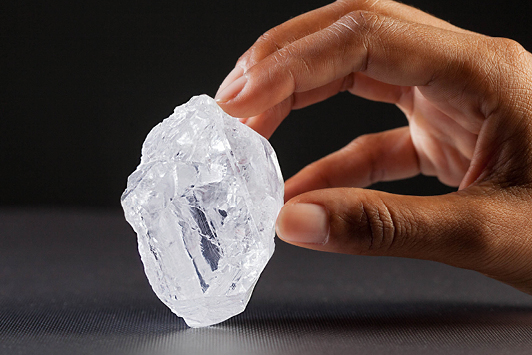
It’s been nearly two years since Tiroyaone Mathaba had his eureka moment. The then-27-year-old was working as a trainee sorter at Lucara Diamond Corp.’s Karowe mine in Botswana, sifting through rock and sand when he realized the tennis-ball-sized stone in his hand was, in fact, a diamond.
“At first I wanted to scream,” he told news outlets at the time. “Then I said in a low, hoarse voice, ‘God, it’s a diamond! It’s a diamond, it’s a big diamond!’”
Lucara used more thought-out superlatives in the aftermath to describe the 1,109-carat discovery. Not since 1905, when the iconic Cullinan diamond was unearthed in South Africa, had the world seen a rough stone of such magnitude. As a rare type IIa rough stone, there was also a strong probability it would emerge as a high-clarity, D-color polished.
But the resulting polished was a long way off, and debate stirred about what to do with the rough, which was soon named Lesedi La Rona — meaning “Our Light” in the local Tswana language.
Lucara took an unconventional approach for the sale of a large rough diamond, hiring Sotheby’s to auction it off. Lucara CEO William Lamb was also touting the idea that given the historic nature of the piece, it might stay in its rough form as a collector’s item.
Meanwhile, Lucara was working under the radar to sell two other exceptional rough diamonds recovered around the same time at Karowe, weighing in at 813 carats and 373.72 carats respectively. The latter was a shard that had broken away from Lesedi La Rona. While Sotheby’s embarked on a headline-grabbing roadshow for its auction, Lucara sold the 813-carat diamond for a record $63.1 million in May 2016. The buyers, a partnership between Dubai-based manufacturer Nemesis International and Swiss jeweler De Grisogono, named it The Constellation.
However, anticipation was building for the bigger prize; Lesedi La Rona was set to go under the hammer in London a month later. The auction house, more accustomed to selling high-value diamond jewelry than rough, set a pre-sale estimate of $70 million for the stone, with onlookers sensing it was being conservative given The Constellation’s price-tag.
But there was audible disappointment when bids ultimately fell below the stone’s reserve price. One bid came in at $51 million, and when the auctioneer’s calls for other takers to go up to $61 million fell on deaf ears, Lesedi La Rona remained unsold and in Lucara’s possession.
Facing a barrage of questions on when, how and to whom the stone would sell, Lucara subsequently appeared to tone down the hype surrounding the sale. Media reports suggested the company was looking for a partner to polish it and gain a royalty from its eventual purchase.
More than a year after the Sotheby’s auction, Lamb declined to comment on the delayed sale in an interview with Rapaport Magazine.
The company was looking for the right buyer, who would take the diamond through its next stage of evolution — so said Lamb a few days after the interview, when the stone’s sale was finally announced on September 25.
Lucara had sold Lesedi La Rona to Graff Diamonds for $53 million.
That’s significantly less than the value of The Constellation, which remains the most expensive rough diamond ever sold. But the sum shouldn’t be too surprising, as Lesedi La Rona’s average price of $47,777 per carat was in line with what Graff paid when it bought the 373.72-carat shard for $17.5 million in May. There’s a certain romance in reuniting the two diamonds.
Laurence Graff, the jeweler’s founder and chairman, called the Lesedi La Rona purchase a “momentous day” in his career. He also hinted at what might come next for this “incredible” diamond. “The stone will tell us its story,” he explained. “It will dictate how it wants to be cut, and we will take the utmost care to respect its exceptional properties.”
It’s a story that’s already had its share of drama in the two years since Mathaba proclaimed it “a big diamond.” And few will dispute the responsibility Graff has assumed for the next stage of its journey. One thing is for sure: Lesedi La Rona ranks among the most fascinating diamonds of our time. One expects the resulting polished to be as spectacular as the rough.
Image: Donald Browers for Sotheby'sArticle from the Rapaport Magazine - October 2017. To subscribe click here.